Chapter: Electrical and electronics : Circuit Theory : Analysing Three Phase Circuits
Analysing Three Phase Circuits
ANALYSING THREE PHASE CIRCUITS
introduction:
a. For
household applications, we use single phase AC supply. But industries or big
consumers are consuming large amount of power.
b. Single
phase supply is not sufficient for producing large amount of power.
d.
Advantages
of Three phase Supply:
a. Most of the electric power is generated and
distributed in three-phase.
1. The instantaneous
power in a three-phase system can be constant.
2. The
amount of power, the three-phase system is more economical that the
single-phase.
b. In fact,
the amount of wire required for a three-phase system is less than that required
for an equivalent single-phase system
c. Three
phase induction motors are self starting unlike single phase induction motors.
d. Three
phase machines have better power factor and efficiency.
e. For the
same size, the capacity of a three phase machine is higher.
Phasor diagram of three phase supply:
Star Connection:
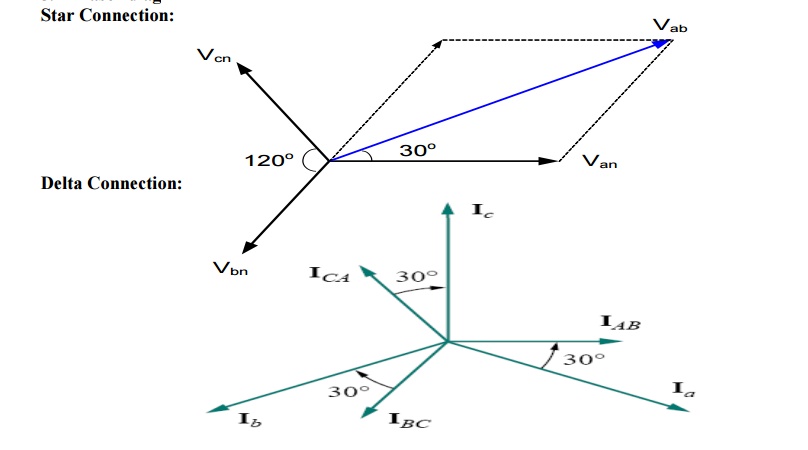
Connection
of Three phases supply:
1 Star connection:
a. The
terminals R, Y and B are connected together to form the star point, also called
the neutral
(N).
b.The
lines R, Y and B are connected to the load. If the neutral is connected to the
neutral of the load.
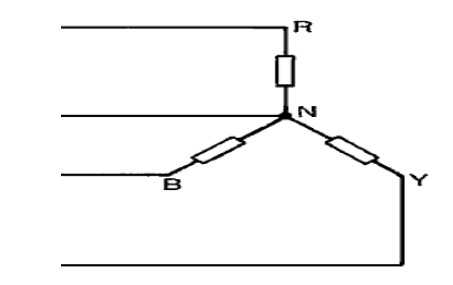
Line
Voltage:
The voltage between the any two lines is
called line voltage.
The
voltage between the line and neutral point is called phase voltage.
Relation between the line voltage and phase
voltage:

Line
current:
o
The current through the line is called line
current.
Phase current:
o
The current through in any phase winding is called
Phase current.
Relation between the line current and phase
current:
IL=IPH
i.
Delta
Connection:
1) The end
of the one winding R is connected to the start of the next phase winding Y.
this connection form delta or mesh connection.
Relation between the line voltage and phase voltage:
VL=VPH
Relation between the line current and phase
current:
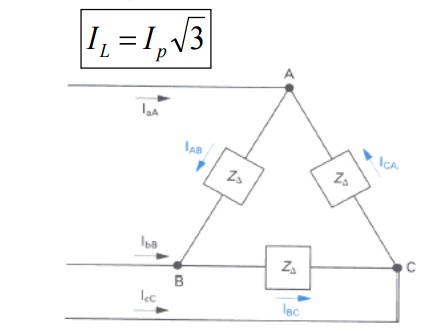
ii.
Comparison
of star and delta connection:
ü Loads
connected in delta dissipate three times more power than when connected in star
to the same supply.
ü For the
same power, the phase currents must be the same for both delta and star
connections (since power=3I p2Rp), hence the line current in the delta
connected system is greater than the line current in the corresponding
star-connected system.
ü To
achieve the same phase current in a star-connected system as in a
delta-connected system, the line voltage in the star system is √ 3 times the
line voltage in the delta system.
ü Thus for
a given power transfer, a delta system is associated with larger line currents
(and thus larger conductor cross sectional area) and a star system is
associated with a larger line voltage (and thus greater insulation).
b. Three phase balanced and unbalanced voltage
sources:
i.
Balanced
Voltage Sources:
5)
If the voltage source have the same amplitude and
frequency ω and are out of phase with each other by 120o, the
voltage are said to be balanced
ii.
Unbalanced
Voltage Sources:
6)
If the voltage source have the different amplitude
and frequency ω and are out of phase with each other by 120o, the
voltage are said to be balanced
iii.
Balanced
load:
7)
A balanced
load is one in which the phase impedances are equal in magnitude and in
phase
iv.
Unbalanced
load:
8) An unbalanced load is one in which the
phase impedances are different in magnitude and phases.
1.
Types of
Unbalanced load:
9) Unbalanced
3 wire star connected load
10)
Unbalanced 4 wire star connected load
11)
Unbalanced 3 wire delta connected load
b. Analysis of 3phase 3 wire with star &
delta connected loads:
i.
Star
Connected load:
Consider a
Y-connected load. We
will derive the
relationships of voltage,
current and power
for this connection.
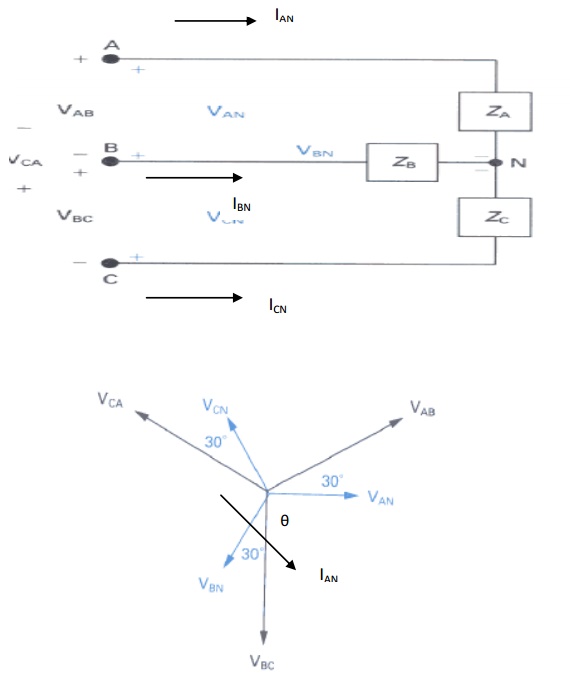
Fig. Three phase Y-connection and
phasor diagram
Assume
that we are given the phase voltages (sequence ABC):

We want
to find the line voltages VAB, VBC and VCA.
Using
KVL,
VAB = VAN+VNBNB
= VAN - VBN
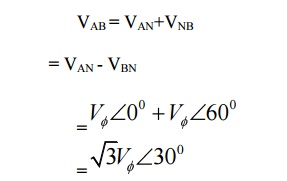
This can
be seen in the phasor diagram. Similarly, you can find the other line voltages
as,

See the
phasor diagram above.
For the
Y-connected three phase system, we observe that:
Line
voltage =√3 Phase Voltage
Line
current, IL = Phase current, Iφ
Line
voltage VAB is ahead of phase voltage VAN by 300
Total
power, PT = 3 Power per phase

Note: The
power factor angle θ is the angle between phase voltage VAN and
phase current IAN.
2. Delta connected load:
Consider
now a -connected load. The circuit connection and phasor diagram showing the
voltages and currents for the balanced circuit is shown below.
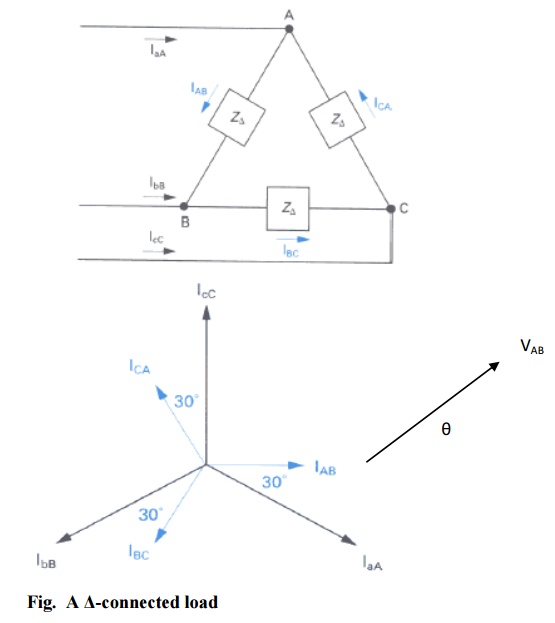
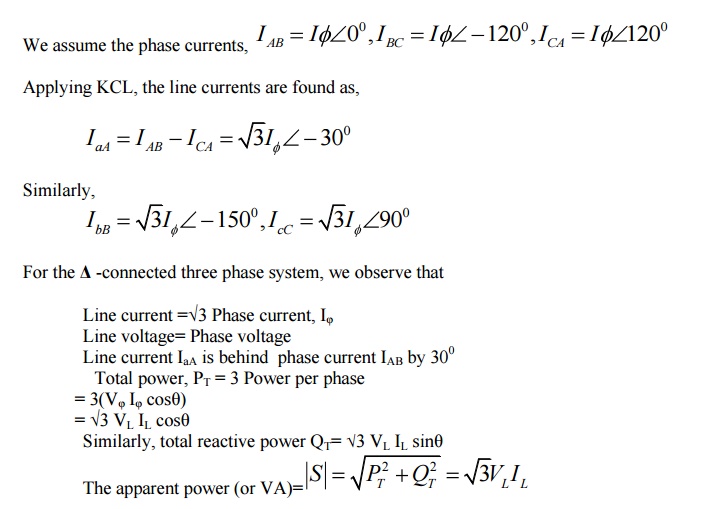
Note
again: The power factor angle θ is the angle between phase voltage VAB
and phase current IAB.
c. Measurements of power & power factor in
3phase circuits:
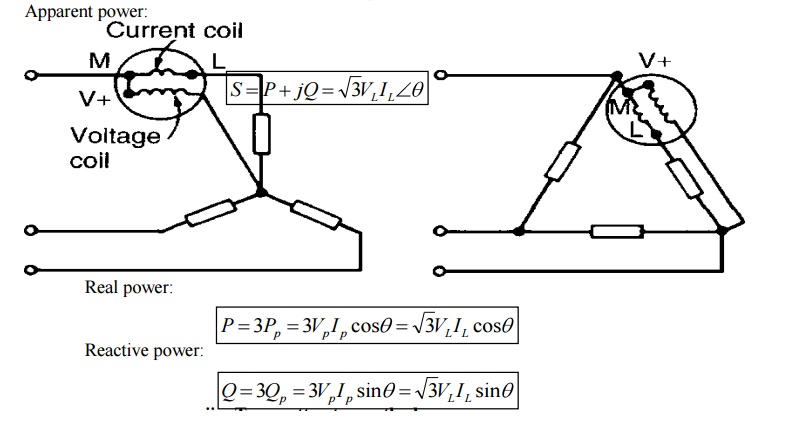
ii. Two
wattmeter method
The
connection and phasor diagram are shown for an assumed abc phase sequence and
lagging power factor.

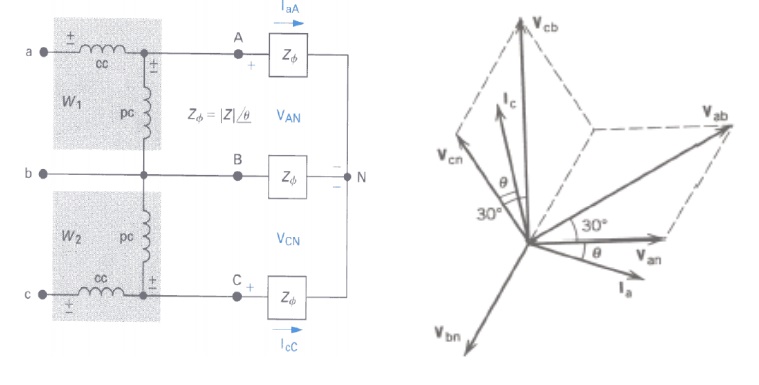
Fig. Two-wattmeter method- connection diagram and
phasor diagram
The watt-meter
readings are given by,

The sum
of the two watt-meter readings gives the total three phase power,

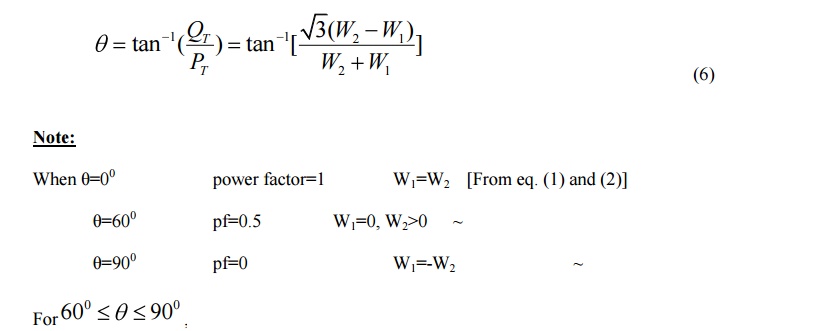
one of
the watt-meters will give negative readings. In the laboratory, when you have
made the proper watt-meter connections, you will observe that one of the
watt-meters is trying to read backwards. After switching the power supply off,
reverse the connection of the voltage coil or the current coil (not both). The
meter will now read upscale. Assign a negative sign to this reading.
Advantages of Two wattmeter
method:
1. The
method is applicable for balanced as well as unbalanced loads.
2. Only two
wattmeter sufficient to measure total 3 phase power.
3. If the
load is balanced not only the power but power factor also can be determined.
Disadvantages:
1. Not
applicable for 3 phases, 4 wire system.
2.
The sign of w1 & w2 must be identified and
noted down correctly otherwise it may lead to the wrong result.
Problems
1.
The input
power to a 3-phase a.c. motor is measured as 5kW. If the voltage and current to
the motor are 400V and 8.6A respectively, determine the power factor of the
system?
Power P=5000W,
line
voltage VL = 400 V,
line
current, IL = 8.6A and
power, P =√3
VLIL cos φ
Hence
power factor = cos φ =
P √3 VLIL
= 5000 √3
(400) (8.6)
= 0.839
2.
Two
wattmeters are connected to measure the input power to a balanced 3-phase load
by the two-wattmeter method. If the instrument readings are 8kW and 4kW,
determine (a) the total power input and (b) the load power factor.
(a)Total
input power,
P=P1 +P2
=8+4=12kW
(b) tan φ =√3(P1 − P2)/(P1 + P2)
=√3 (8 –
4) / (8 + 4)
=√3
(4/12)
=√3(1/3)
= 1/ √3
Hence φ= tan−1 1 √3 =30◦
Power factor= cos
φ= cos 30◦ =0.866
3.
Two
wattmeters connected to a 3-phase motor indicate the total power input to be
12kW. The power factor is 0.6. Determine the readings of each wattmeter.
If the
two wattmeters indicate P1 and P2 respectively
|
Then P1 + P2 = 12kW |
---(1) |
tan φ =√3(P1 − P2)/(P1 + P2)
And power
factor=0.6= cos φ.
Angle φ= cos−10.6=53.13◦ and
tan 53.13◦ =1.3333.
Hence
1.3333 =√3(P1 − P2)/12
From
which,
P1 − P2 =
12(1.3333) /√3
i.e. P1 −P2
=9.237kW ----(2)
Adding
Equations (1) and (2) gives:
2P1 = 21.237
i.e P1 = 21.237/2
= 10.62kW
Hence wattmeter 1 reads 10.62kW From Equation (1), wattmeter 2 reads
(12−10.62)=1.38kW
4.
Three
loads, each of resistance 30, are connected in star to a 415 V, 3-phase supply.
Determine
(a) the system phase voltage, (b)
the phase current and (c) the line current.
A ‘415 V,
3-phase supply’ means that 415 V is the line voltage, VL
(a) For a
star connection, VL =√3Vp Hence phase voltage, Vp = VL/√3
= 415 /√3
= 239.6 V or 240 V
correct
to 3 significant figures
(b) Phase
current, Ip = Vp/Rp
= 240/30
= 8 A
(c) For a
star connection, Ip = IL Hence the line current, IL = 8 A
5.
Three
identical coils, each of resistance 10ohm
and inductance 42mH are connected (a) in star and (b) in delta to a 415V, 50
Hz, 3-phase supply. Determine the total power dissipated in each case.
(a) Star connection
Inductive
reactance,
XL =2πf L =2π (50) (42×10−3) =13.19
Phase
impedance,
Zp =√(R2 +XL2)
=√(102
+13.192) =16.55
Line
voltage, VL =415 V
And phase
voltage,
VP =VL/√3=415/√3=240 V.
Phase
current,
Ip =Vp/Zp
=240/16.55=14.50 A. Line current,
IL =Ip =14.50 A.
Power factor= cos φ=Rp/Zp =10/16.55 =0.6042 lagging.
Power dissipated,
P =√3 VLIL
cos
φ =√3 (415) (14.50)(0.6042) = 6.3kW (Alternatively,
P =3I2R =3(14.50)2(10)=6.3kW)
(b) Delta connection
VL = Vp = 415 V,
Zp = 16.55_, cos φ = 0.6042 lagging (from
above). Phase current,
Ip =Vp/Zp =415/16.55=25.08A.
Line current,
IL =√3Ip =√3(25.08)=43.44A.
Power dissipated,
P =√3 VLIL
cos
φ
=√3
(415)(43.44)(0.6042) = 18.87kW
(Alternatively,
P =3I2R
=3(25.08)2(10) =18.87 kW)
6.
A 415V,
3-phase a.c. motor has a power output of 12.75kW and operates at a power factor
of 0.77 lagging and with an efficiency of 85 per cent. If the motor is
delta-connected, determine (a) the power input, (b) the line current and (c)
the phase current.
(a) Efficiency=power output/power input.
Hence
(85/100)=12.750 power input from which, Power input = 12. 750 × 10085
= 15 000W or 15Kw
(b) Power, P=√3 VLIL cos φ, hence
(c) line current,
IL = P/ √3 (415) (0.77)
= 15 000/
√3 (415) (0.77)
= 27.10A
(d) For a
delta connection, IL =√3 Ip,
Hence
Phase current, Ip = IL/√3
= 27.10 /√3
= 15.65A
7.
A 400V,
3-phase star connected alternator supplies a delta-connected load, each phase
of which has a resistance of 30_ and
inductive reactance 40_. Calculate
(a) the current supplied by the alternator and (b) the output power and the kVA
of the alternator, neglecting losses in the line between the alternator and
load.
A circuit
diagram of the alternator and load is shown in Fig.
(a) Considering the load:
Phase
current, Ip =Vp/Zp
Vp =VL for a delta connection,
Hence Vp =400V.
Phase
impedance,
Zp =√ (R2+XL2)
=√ (302
+402) =50

Figure
Hence Ip =Vp/Zp =400/50=8A.
For a
delta-connection,
Line
current, IL =√3 Ip =√3 (8) =13.86 A.
Hence 13.86A is the current supplied by the
alternator.
(b)
Alternator output power is equal to the power Dissipated by the load
I.e. P =√3 VLIL cos φ, Where cos φ = Rp/Zp = 30/50 = 0.6.
Hence P
=√3 (400) (13.86) (0.6) = 5.76kW.
Alternator
output kVA,
S =√3 VLIL
=√3 (400) (13.86)
9.60 kVA.
Related Topics